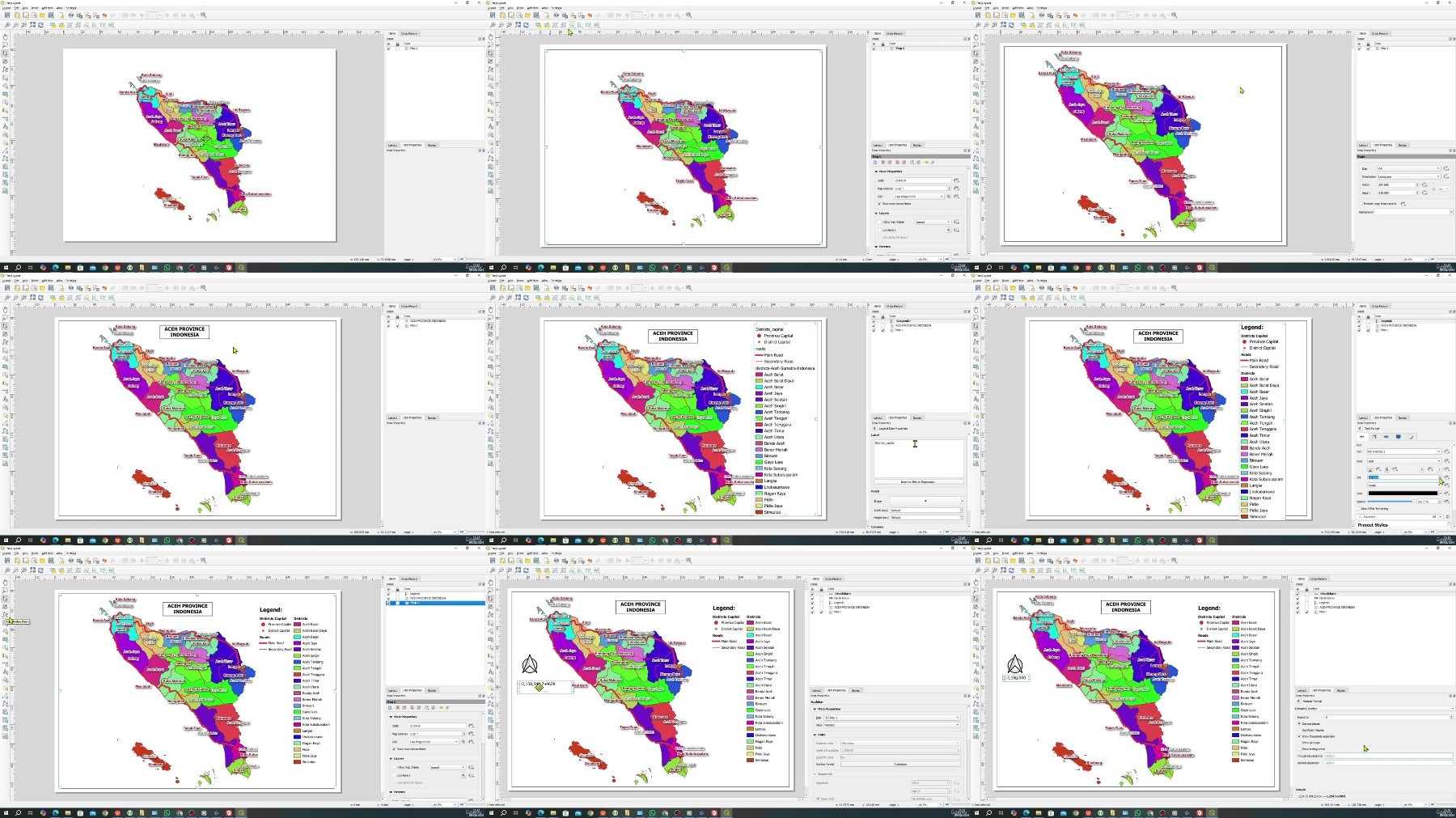Bluff Series : Mastering Qgis Desktop 3.34.X

Bluff Series : Mastering Qgis Desktop 3.34.X
Published 8/2024
MP4 | Video: h264, 1920x1080 | Audio: AAC, 44.1 KHz
Language: English | Size: 1.40 GB | Duration: 3h 0m
Expand or start GIS skill with this course, include map navigation, georeferencing, digitizing, thematic map and layout
What you'll learn
Download and Installation of QGIS Desktop 3.34.x
Explore QGIS Interface and Basic Navigation (Panels, Toolbars, Pan, Zooming)
Managing Geospatial Data (Add XYZ Basemap, Display data into QGIS Canvas and Create Thematic/Choropleth Map)
Create Common Rasters/Images into Georeferenced Ones
Digitizing Vector Layer Based on Georeferenced Raster (Polygons, Polylines and Points)
Designing Layout to be Printed on Papers or Export to JPGs or PDFs
Requirements
No need GIS experience before, just require simple operation in operating Microsoft Windows
Tutorial is produced in Microsoft Windows 10 but for Linux and Mac users are welcome. QGIS is designed for Ms Windows, Linux and Mac
Description
Mastering QGIS Desktop 3.34.x LTR provides an introduction to using QGIS, a powerful open-source software for spatial data analysis and mapping. This training is designed for beginners who want to develop skills in GIS, with no prior experience required.Participants learn the fundamental concepts of GIS, such as downloading and installing QGIS software, understanding spatial data types, coordinate systems, and map projections. The training covers the QGIS interface, including how to navigate the map canvas, use toolbars, and manage layers. Students are introduced to working with vector and raster data, including importing, visualizing, and performing basic data manipulation. And also how to georeferencing raster data and digitize feature on itHands-on exercises guide participants through creating and editing shapefiles, applying symbology to represent data meaningfully, and using attribute tables for data analysis. Participants will gain practical experience in creating a layout map by adding legends, scale bars, and exporting the final product for printing or sharing it with JPG or PDF format.By the end of the training, participants will have a solid understanding of QGIS basics, enabling them to perform simple spatial analysis tasks and create professional-looking maps. This foundational knowledge sets the stage for more advanced GIS techniques and applications.
Overview
Section 1: Introduction, Download and Install QGIS Desktop 3.34.x LTR
Lecture 1 Explanation of big picture of sections in this course
Lecture 2 Download and Installation QGIS Desktop 3.34.x LTR
Section 2: QGIS Interface, Projects and Basic Navigation
Lecture 3 Create favorite for shortcuts
Lecture 4 Load SHP and save projects
Lecture 5 Panels and Toolbars
Lecture 6 Change CRS and change coordinate format on the fly
Lecture 7 Differences between QGS and QGZ project file format
Lecture 8 Map Navigation- Zoom, pan, scroll, attribute table and identify
Section 3: Managing Geospatial Data
Lecture 9 Display XYZ Tile as basemap - OpenStreetMap. GoogleSatellite and GoogleStreet
Lecture 10 Convert spatial data into other formats
Lecture 11 SHP and GeoJSON File Structure
Lecture 12 Thematic map-Symbology and labeling layer-Polygon feature
Lecture 13 Thematic map–Symbology and labeling layer-Polyline feature
Lecture 14 Thematic map–Symbology and labeling layer-Point feature
Lecture 15 Data filter and selection
Lecture 16 Analyzing and Import data raster-GeoTIFF
Section 4: Georeferencing Raster Data
Lecture 17 Preparing UnGeoreferenced raster
Lecture 18 Georeferencing Raster Data Decimal Degree (DD)
Lecture 19 Georeferencing Raster Data Degree Minutes Second (DMS)
Lecture 20 Georeferencing Raster Data (No coordinate information)
Section 5: Digitizing Vector Data
Lecture 21 Export XYZ data as offline raster for digitizing
Lecture 22 Create new polygon feature and digitizing
Lecture 23 Create new polyline feature and digitizing
Lecture 24 Create new point feature and Digitizing
Lecture 25 Add/remove fields
Section 6: Designing Layout
Lecture 26 Insert layout objects
Lecture 27 Insert grid and calculation
Lecture 28 Export to JPG and PDF
The tutorials are for GIS Beginners or no GIS experience before but want to start career in GIS industry or leverage existing GIS skill.,Skilled one? No problem, maybe you want to see other's GIS practitioner's point of view of operating QGIS software.

What you'll learn
Download and Installation of QGIS Desktop 3.34.x
Explore QGIS Interface and Basic Navigation (Panels, Toolbars, Pan, Zooming)
Managing Geospatial Data (Add XYZ Basemap, Display data into QGIS Canvas and Create Thematic/Choropleth Map)
Create Common Rasters/Images into Georeferenced Ones
Digitizing Vector Layer Based on Georeferenced Raster (Polygons, Polylines and Points)
Designing Layout to be Printed on Papers or Export to JPGs or PDFs
Requirements
No need GIS experience before, just require simple operation in operating Microsoft Windows
Tutorial is produced in Microsoft Windows 10 but for Linux and Mac users are welcome. QGIS is designed for Ms Windows, Linux and Mac
Description
Mastering QGIS Desktop 3.34.x LTR provides an introduction to using QGIS, a powerful open-source software for spatial data analysis and mapping. This training is designed for beginners who want to develop skills in GIS, with no prior experience required.Participants learn the fundamental concepts of GIS, such as downloading and installing QGIS software, understanding spatial data types, coordinate systems, and map projections. The training covers the QGIS interface, including how to navigate the map canvas, use toolbars, and manage layers. Students are introduced to working with vector and raster data, including importing, visualizing, and performing basic data manipulation. And also how to georeferencing raster data and digitize feature on itHands-on exercises guide participants through creating and editing shapefiles, applying symbology to represent data meaningfully, and using attribute tables for data analysis. Participants will gain practical experience in creating a layout map by adding legends, scale bars, and exporting the final product for printing or sharing it with JPG or PDF format.By the end of the training, participants will have a solid understanding of QGIS basics, enabling them to perform simple spatial analysis tasks and create professional-looking maps. This foundational knowledge sets the stage for more advanced GIS techniques and applications.
Overview
Section 1: Introduction, Download and Install QGIS Desktop 3.34.x LTR
Lecture 1 Explanation of big picture of sections in this course
Lecture 2 Download and Installation QGIS Desktop 3.34.x LTR
Section 2: QGIS Interface, Projects and Basic Navigation
Lecture 3 Create favorite for shortcuts
Lecture 4 Load SHP and save projects
Lecture 5 Panels and Toolbars
Lecture 6 Change CRS and change coordinate format on the fly
Lecture 7 Differences between QGS and QGZ project file format
Lecture 8 Map Navigation- Zoom, pan, scroll, attribute table and identify
Section 3: Managing Geospatial Data
Lecture 9 Display XYZ Tile as basemap - OpenStreetMap. GoogleSatellite and GoogleStreet
Lecture 10 Convert spatial data into other formats
Lecture 11 SHP and GeoJSON File Structure
Lecture 12 Thematic map-Symbology and labeling layer-Polygon feature
Lecture 13 Thematic map–Symbology and labeling layer-Polyline feature
Lecture 14 Thematic map–Symbology and labeling layer-Point feature
Lecture 15 Data filter and selection
Lecture 16 Analyzing and Import data raster-GeoTIFF
Section 4: Georeferencing Raster Data
Lecture 17 Preparing UnGeoreferenced raster
Lecture 18 Georeferencing Raster Data Decimal Degree (DD)
Lecture 19 Georeferencing Raster Data Degree Minutes Second (DMS)
Lecture 20 Georeferencing Raster Data (No coordinate information)
Section 5: Digitizing Vector Data
Lecture 21 Export XYZ data as offline raster for digitizing
Lecture 22 Create new polygon feature and digitizing
Lecture 23 Create new polyline feature and digitizing
Lecture 24 Create new point feature and Digitizing
Lecture 25 Add/remove fields
Section 6: Designing Layout
Lecture 26 Insert layout objects
Lecture 27 Insert grid and calculation
Lecture 28 Export to JPG and PDF
The tutorials are for GIS Beginners or no GIS experience before but want to start career in GIS industry or leverage existing GIS skill.,Skilled one? No problem, maybe you want to see other's GIS practitioner's point of view of operating QGIS software.

